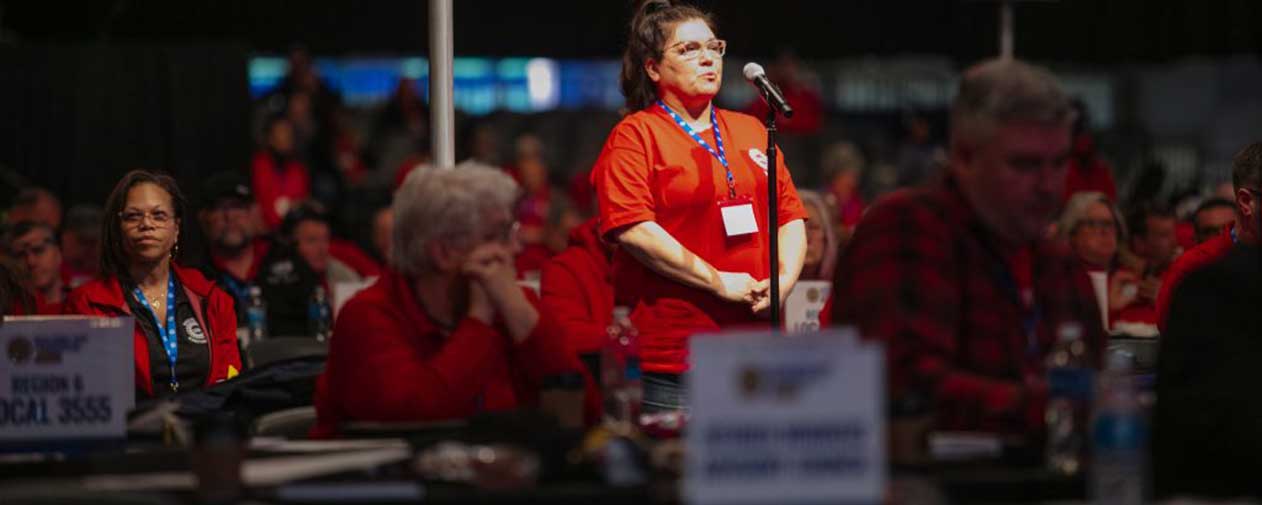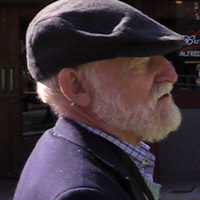From opening uncertainty to a path forward – People’s World

[ad_1]

The UAW concluded its Special Bargaining Convention, with members taking up issues of work schedules, the contractual right to honor other unions’ picket lines, and more. UAW
DETROIT—The Auto Workers’ bargaining convention in Detroit last month opened in uncertainty –who would lead it–and ended in setting tough priorities for upcoming talks with the Detroit 3.
The uncertainty loomed because it was unclear, until the day before the March 27 start, that Shawn Fain, the challenger to incumbent Ray Curry in the union’s first-ever one-member one-vote election, had actually won the presidency of the historically prestigious, but recently troubled UAW.
Fain, an electrician from Local 1166 in Kokomo, Ind., and the new 14-person executive board, with a majority from his slate, was sworn in the day before he opened the 600-delegate conclave. In a sign of unity, Curry swore him in.
The one-member one-vote system was a historic change and added UAW to the slowly lengthening list of unions whose leaders are elected by popular vote, not by convention delegates. Others include The News Guild, the Teamsters, the Laborers, and the Brotherhood of Locomotive Engineers and Trainmen, a Teamsters sector.
UAW’s change was a result of the consent decree the federal Labor Department ordered in the wake of corruption convictions of over a dozen UAW leaders. Past presidents Dennis Williams and Gary Jones were convicted and sent to jail. The decree also ordered a referendum to see if members wanted to go to a one-member one-vote system to elect top leaders or continue with the convention delegate system. One-member one-vote passed handily.
The referendum set up the race between Curry, candidate of the incumbent Administration Caucus–which has run UAW since 1948–and Fain, candidate of the reformers, named Unite All Workers for Democracy (UAW-D).
UAWD is a rank-and-file caucus started in 2019 amid the 2019 GM strike and organized around the slogan “No Corruption, No Concessions, No Tiers,” referring to the two-tier wage and benefits system the Detroit 3 imposed on UAW and its members after the 2008 financier-caused Great Recession plunged GM and FiatChrysler into bankruptcy.
The one-member-one-vote elections gave UAWD an executive board majority and elected Margaret Mock as UAW’s first-ever African-American woman Secretary-Treasurer. In the runoff, VP candidate Chuck Browning ran with the Administrative Caucus but was supported by both Curry and Fain.
The major concern was whether the leadership and delegates would be able to unite on going after the companies or split into factionalism. The first positive sign was when Curry agreed to install Fain on Sunday, the day before the convention began, so Fain could gavel it to order. The second occurred at the Administrative Caucus meeting Monday before the Convention began, chaired by Browning. Both Curry and Browning spoke for the need to put the election behind them and unite in preparations for upcoming negotiations, especially with the Big 3. As the convention unfolded it became clear that both sides were searching for unity.
Example of unity
The clearest example of the developing unity was the report on the conclave’s last day, March 29, by Browning, whose responsibilities include the Ford division and Agricultural Implements. He gave a detailed report on the strikes at John Deere, Case New Holland, and the contract fight at Caterpillar.
In all cases, Browning credited the militancy and solidarity of the bargaining committees and members. At Caterpillar, described as “one of the meanest companies the union deals with,” the union had picket signs ready and expected to walk at midnight. At the last minute, the company blinked and the union won its economic demands.
As Browning introduced the Ford national bargaining committee, he spoke about how the union fought to keep the Ohio Assembly plant in Avon Lake open. As part of the 2019 negotiations, Ford agreed to invest $900 million in that plant.
Soon after, new management at Ford reneged on that commitment. Browning began to file strikeable grievances throughout the Ford system and threatened to shut down production of the F-150s and other vehicles, a popular and profitable model. The company caved in and committed $1.3 billion to keep Ohio Assembly open.
Browning also spoke about the “damn elephant in the room,” the recent elections which—like many union elections–were pretty intense. He said there is one agenda, and that is the membership’s agenda. He referred to Fain as his friend and as his president several times.
And he said it is a good time to bargain, “Strikes are effective.” Browning received repeated standing ovations from the entire convention. His remarks as well as the closing remarks of Fain are on the UAW website (insert link) and available for all to read. After Fain finished his closing remarks the convention ended with the singing of Solidarity Forever.
The convention’s main resolution set bargaining objectives for upcoming negotiations in all UAW sectors. Resolutions came in from almost every UAW local. The Resolutions Committee whittled a 4-inch-thick book of proposals down to one omnibus resolution.
The main issues in all sectors are the elimination of the tiers system, health care and pensions for all, and COLAs, referring to cost of living adjustments. Another huge issue in the Big 3 is forcing the companies to put all new battery plants and all plants with components of electrical vehicle operations under the master agreements.
If the companies get their way these plants would have lower wages and benefits and prohibit transfers should engine and transmission plants begin losing production.
The union’s argument is that batteries are another newer form of the powertrain which is a major component of the union’s membership. One resolution brought to the floor was to insert provisions into contracts that no member could be forced to cross a picket line of another union at the same facility. It passed unanimously. Another was from the academic sector on building Student Worker Solidarity that also passed.
It was clear by the end of the convention that a level of unity was forged at the convention on mounting a fightback against the cutbacks and concessions the companies won since 2008. And that unity will be easier to win at the plant floor level.
Workers are less concerned about who leads them as long as those leaders are honest and willing to fight. The UAWD was able to win the referendum, elect its candidates and push its main agenda of fighting back against concessions and tiers. And the incumbents on the executive board and other delegates generally speaking chose unity over confrontation. It bodes well for workers in the upcoming contract negotiations and beyond. It truly is a new day in the UAW.
[ad_2]
Source link


